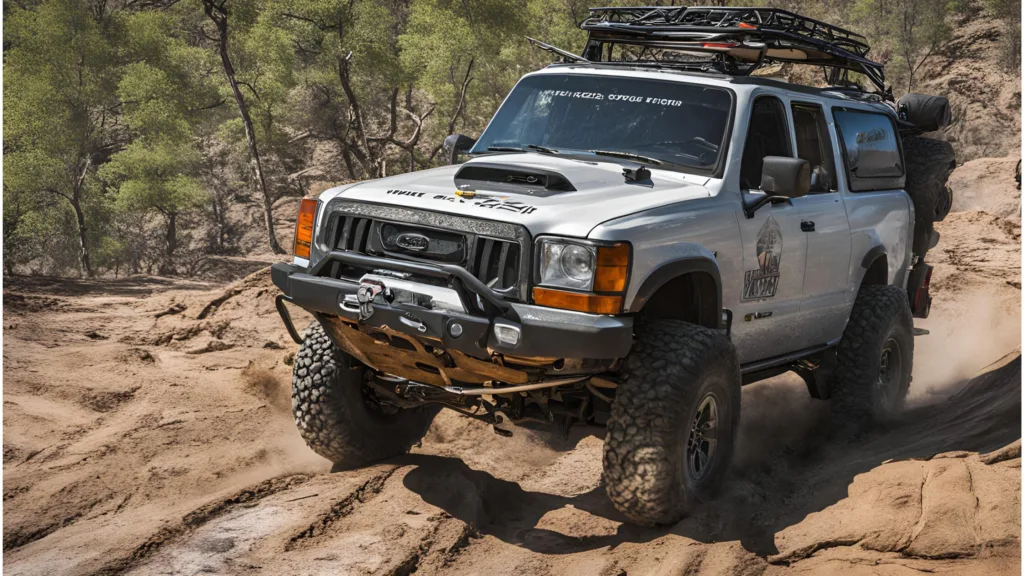For Off-Road Survival Tips, stay calm and prioritize finding water, shelter, and food. Always carry a basic survival kit and inform others of your route before departure.
Venturing off the beaten path can offer exhilarating experiences and unparalleled adventure, yet it also poses unique challenges requiring specific survival skills. Whether you’re an avid hiker, an off-road driver, or simply love exploring natural landscapes, the unpredictability of remote environments means that preparation and knowledge are your best tools for staying safe.
It’s crucial to understand the terrain, weather patterns, and your own physical limitations. A well-rounded Off-Road Survival Tips introduction equips adventurers with the essentials: navigation techniques, risk assessment, emergency signaling methods, and the ability to adapt to unexpected situations. By mastering these principles, off-road enthusiasts can embrace the wilderness with confidence and security.

The Essentials Of Off-road Preparedness
Embarking on an off-road adventure excites and challenges many outdoor enthusiasts. Thrills come with risks. Preparedness is key. Knowing what to pack, check, and expect ensures a safe and enjoyable experience. Here we’ll dive into the essentials: the gear to carry on board and the crucial vehicle checks before leaving.
Gear To Always Carry
Success in off-road trips heavily depends on the gear you pack. Always be ready for the unexpected. A comprehensive kit can make the difference in emergencies. Below lies a checklist of must-have items.
- First-Aid Kit: Bandages, antiseptics, and splints are crucial.
- Recovery Gear: Include a winch, tow strap, and shackles.
- Navigation Tools: Maps, compass, or GPS for unexpected detours.
- Communication Devices: Satellite phone or radio can be lifesavers.
- Food and Water: Non-perishable snacks and plenty of water.
- Survival Tools: A multitool, firestarter, and knife cover basic needs.
Vehicle Checks Before Hitting The Trail
Your vehicle is your lifeline. A thorough check before departure is essential. Addressing issues at home is better than in the wilderness. Follow this guide to ensure your ride is trail-ready.
| Check Item | Description |
|---|---|
| Tires | Inspect for wear and ensure proper inflation. |
| Fluids | Check oil, coolant, and brake fluid levels. |
| Brakes | Test for responsiveness and wear. |
| Lights | Ensure all are functioning correctly. |
| Battery | Verify it’s fully charged and terminals are clean. |
| Belts and Hoses | Check for cracks or signs of wear. |

Navigating Unfamiliar Terrain
Exploring the great outdoors means sometimes treading into unknown lands. Mastering navigation skills is essential for any off-road adventure. Let’s unlock the secrets to confidently move through unfamiliar terrain. Knowing where you are and where you’re going can save your life.
Reading Topographic Maps
Topographic maps tell the story of the land. They show hills, valleys, rivers, and more. Here’s how to use them:
- Contour lines mark elevation.
- Closer lines mean steeper hills.
- Colors show different types of land.
Start with a basic map to get familiar. Practice at home before your trip.
Understanding Your Gps
A GPS device is a modern compass. It guides you through the wild. Here’s how to stay on track:
- Charge your GPS fully before leaving.
- Set waypoints for your start and end.
Use your GPS with a map for best results. Keep a paper map as a backup. Trusting technology alone can be risky.
Water And Food Strategies
Surviving off-road hinges on two essentials: water and food. Proper strategies ensure you stay hydrated and energized. Let’s explore the best ways to secure these life-sustaining resources.
Finding And Purifying Water
Finding water in the wild is critical. Look for streams, rivers, or collect rainwater. Be mindful; not all water is safe to drink. Purifying it is a must.
- Boiling: Heat water for at least one minute to kill harmful organisms.
- Chemical Tablets: Use iodine or chlorine tablets as directed.
- Portable Filters: Carry a filter to remove contaminants.
- UV Light: UV purifiers kill viruses and bacteria quickly.
Always pack purification tools before you head out. You can’t predict where or when you’ll find water.
High-energy Nutrition Choices
Select foods that offer maximum energy with minimal weight. Nutrient-dense options provide the stamina needed for off-road challenges.
| Food Type | Benefits |
|---|---|
| Nuts and Seeds | Rich in fats, protein, and last long without refrigeration. |
| Jerky | High in protein, light, and doesn’t spoil easily. |
| Energy Bars | Compact and designed for sustained energy supply. |
| Dried Fruits | Provide sugars for a quick energy boost. |
Choose vacuum-packed or dehydrated foods to reduce weight and increase shelf life. Always bring more than you think you’ll need. Emergencies happen.
Managing Emergencies In The Wild
Exploring the untamed paths of the wilderness excites many adventurers. Yet with the thrill of off-road exploration comes the unavoidable prospect of emergencies. Mastering emergency management skills is crucial for any off-road enthusiast. Gaining these skills ensures you remain cool-headed when challenges arise. Accidents, injuries, or getting lost can turn a thrilling adventure into a survival situation. Staying prepared with the right knowledge could mean the difference between life and death.
First Aid Fundamentals
First aid proficiency is paramount for outdoor survival. Knowing basic first aid can save lives. Always carry a well-stocked first aid kit on your off-road journeys. Items should include bandages, antiseptic wipes, pain relievers, and tools for splinting.
- Assess the situation: Check for dangers before helping others.
- Protect the injured: Move them away from further harm.
- Stop bleeding: Apply pressure to wounds with clean cloth.
- Address shock: Keep them warm and lying down.
- Monitor vital signs: Watch for changes in breathing and alertness.
Remember, the goal is to stabilize the injured person until professional help can be found
Signal Techniques To Rescue Teams
To attract rescue teams, you need effective signaling techniques. These methods will signal your need for help. Different signals work for day and night use.
| Type | Day Signals | Night Signals |
|---|---|---|
| Visual | Mirrors, bright clothing, smoke | Flares, flashlights, fires |
| Audio | Whistles, shouts, SOS patterns | Loud noises, SOS patterns |
| Physical | Ground symbols, flags | Creating shadows with firelight |
Stay in open areas. Use three of anything, which is a universal distress signal. Three fires, three whistles, three flashes – these catch the attention of rescuers quickly.
Setting Up Camp Off-road
Exciting adventures await when you leave the pavement behind. But with off-road escapades comes the responsibility of setting up a safe and eco-friendly camp. Let’s explore how to pitch your tent without a hitch and cherish the wilderness with minimal impact.
Choosing A Safe Spot
Finding the perfect camping spot is a must for a safe night under the stars. Here’s what to consider:
- Look for level ground: This ensures comfort and stability for your tent.
- Avoid hazards: Stay clear of dead trees and rock fall areas.
- Consider wildlife: Camp away from animal trails to avoid encounters.
- Seek shelter: Use natural formations to protect from wind and rain.
Minimizing Environmental Impact
Enjoy nature without leaving a mark by observing these guidelines:
- Follow Leave No Trace principles: Pack out everything you bring in.
- Use existing campsites: This prevents damage to untouched land.
- Keep fires safe and small: Use a camp stove or designated fire rings.
- Respect wildlife: Observe from a distance and never feed animals.
- Manage waste: Bury human waste properly and wash with biodegradable soap.
Handling Difficult Weather Conditions
Exploring the wild comes with surprises, especially the weather. Off-road enthusiasts must always prepare for climate changes.
Weather conditions can turn harsh and unpredictable. Know what to do when the skies challenge your survival skills. Read on for vital tips.
Surviving Extreme Heat
Blazing temperatures test your limits. Dehydration and heatstroke are real risks in extreme heat. Below are essential tips to stay cool:
- Hydrate: Drink plenty of water. Carry extra water in your vehicle.
- Shade: Create or find shade. Use your vehicle, tarps, or clothing.
- Cool Clothing: Wear light-colored, loose-fitting clothes. They help your body cool.
- Sun Protection: Apply sunscreen and wear a wide-brimmed hat.
- Avoid Midday Sun: Travel in the cooler morning or evening hours.
Staying Safe In Cold And Snow
Cold climates challenge your warmth and navigation. Snow, ice, and freezing temps call for smart strategies:
- Layer Up: Wear multiple layers to trap body heat. Use thermal, wool, or fleece.
- Insulate: Keep an insulated sleeping bag and space blankets in your vehicle.
- Snow Tires and Chains: Equip your vehicle with tires for traction.
- Emergency Kit: Carry a kit including a shovel, torch, and flares.
- Stay Dry: Wet conditions lead to hypothermia. Keep clothes dry.
- Calorie Intake: Eat high-calorie foods to maintain energy levels.
Weather unpredictability demands respect and preparation.
Ensure your gear suits the challenge. Stay aware, stay safe, and enjoy the thrills of off-road adventure.
Essential Off-road Driving Techniques
Adventures on rugged terrains can be thrilling. Yet, without the right techniques, they can turn risky. Master off-road driving with these crucial skills. Learn to navigate through wild trails confidently.
Mastering Tricky Obstacles
- Assess the Terrain: Before attempting any obstacle, stop and investigate the path. Look for the best route to take.
- Go Slow: Approach challenges at a slow speed. It gives you more control over the vehicle.
- Use Low Gears: Engage lower gears for better torque and vehicle handling over obstacles.
- Wheel Placement: Place your wheels strategically to maintain balance and traction.
- Keep Momentum: Maintain a steady momentum to carry your vehicle over obstacles without getting stuck.
Maintaining Vehicle Control
- Remain Calm: A calm driver can make better, safer decisions.
- Steady Throttle: Use a consistent throttle to keep a steady pace and avoid skidding.
- Steer Gently: Avoid sharp turns that can cause rollovers. Steer your vehicle with care.
- Brake Softly: Smooth braking prevents harsh stops and skids on loose surfaces.
- Expect the Unexpected: Be ready for changes in the terrain. Adapt your driving to meet these challenges.
Bonus Tip: Master these techniques through practice in different environments. Each ride improves your skills for the next adventure!

The Importance Of Leaving No Trace
When exploring the wild in your off-road vehicle, leaving no trace should top your survival tips list. By preserving nature, you ensure others can enjoy their adventures too. Follow these principles to protect wildlife and natural habitats.
Environmental Ethics
Taking responsibility for your actions is crucial. Big or small, your actions impact nature. Follow these simple rules:
- Stay on designated paths to avoid harming unspoiled areas.
- Pack out what you pack in, especially your trash.
- Avoid disturbing wildlife or plants.
Practices For Sustainable Off-roading
To enjoy nature without harming it, adopt sustainable practices. For responsible off-roading, remember:
- Use existing campsites; don’t create new ones.
- Reduce vehicle emissions by maintaining your vehicle.
- Join clean-up events, and also plan your trips around established areas.
Frequently Asked Questions On Off-road Survival Tips
What To Pack For Off-road Adventures?
Before setting off, pack a survival kit including water, non-perishable food, a first-aid kit, a multi-tool, a map and compass, a flashlight, and a fire-starting mechanism. Ensure these essentials are easily accessible throughout your journey.
How To Navigate Without Gps Off-road?
Learning to use a topographic map and compass is critical for off-road navigation without GPS. Practice these skills in a familiar area before your trip. Always carry extra batteries or a solar charger for emergencies.
What Are Essential Off-road Driving Techniques?
For off-road driving, it’s important to maintain a steady speed, use low gears, and avoid sudden movements. Always know your vehicle’s clearance and approach angles. Control is key, so practice throttle and brake control extensively.
How To Manage Vehicle Breakdowns Off-road?
Regular vehicle maintenance before an off-road trip is crucial. In case of a breakdown, stay calm, assess the situation, and attempt minor repairs with your toolkit. If the issue is beyond your expertise, signal for help using your emergency devices.
Conclusion
Embarking on off-road adventures can test your endurance and wit. With the right survival tips, such as preparing emergency kits and understanding your environment, you’re set for success. Remember to respect nature’s power and always stay vigilant. Safe travels and embrace every rugged mile with confidence!


